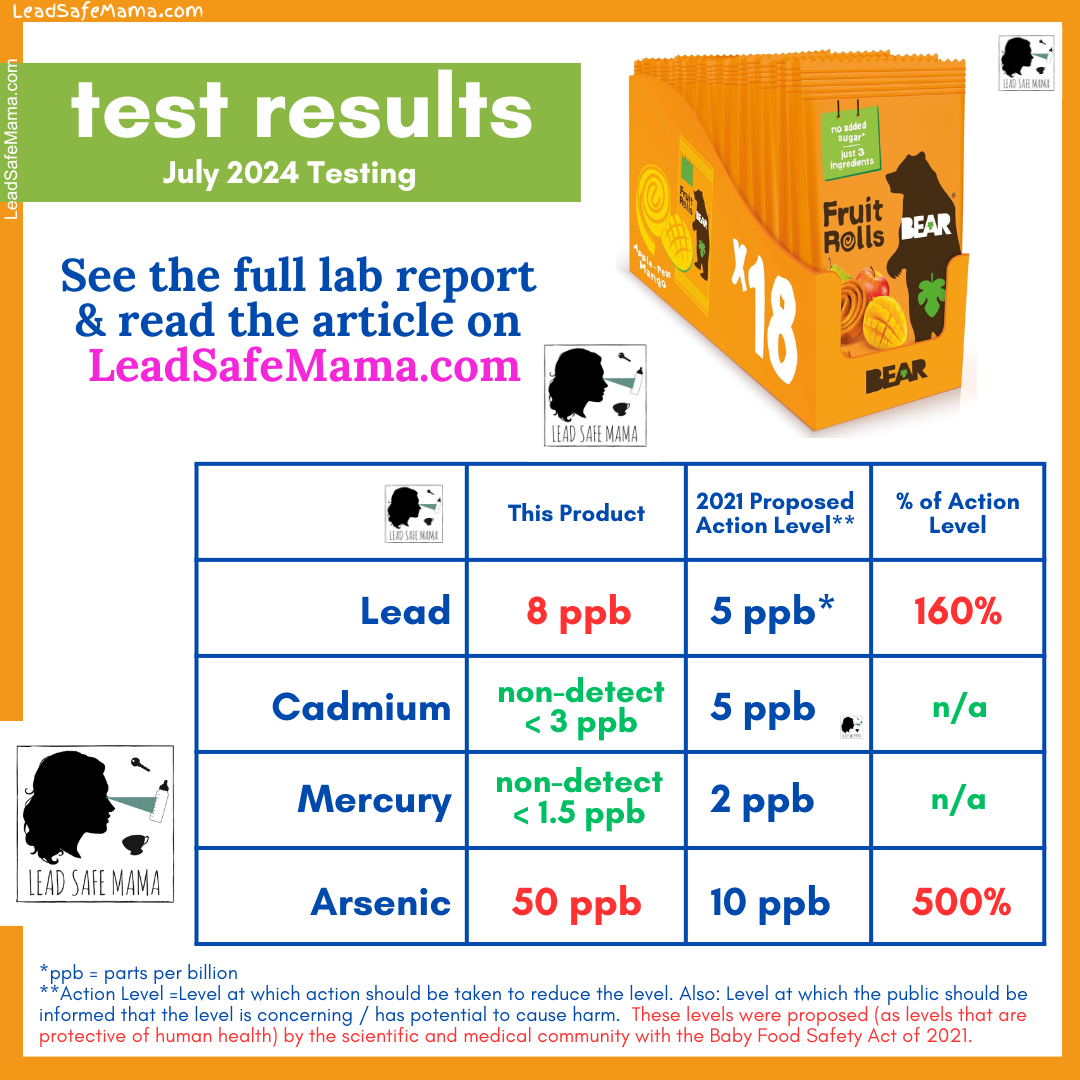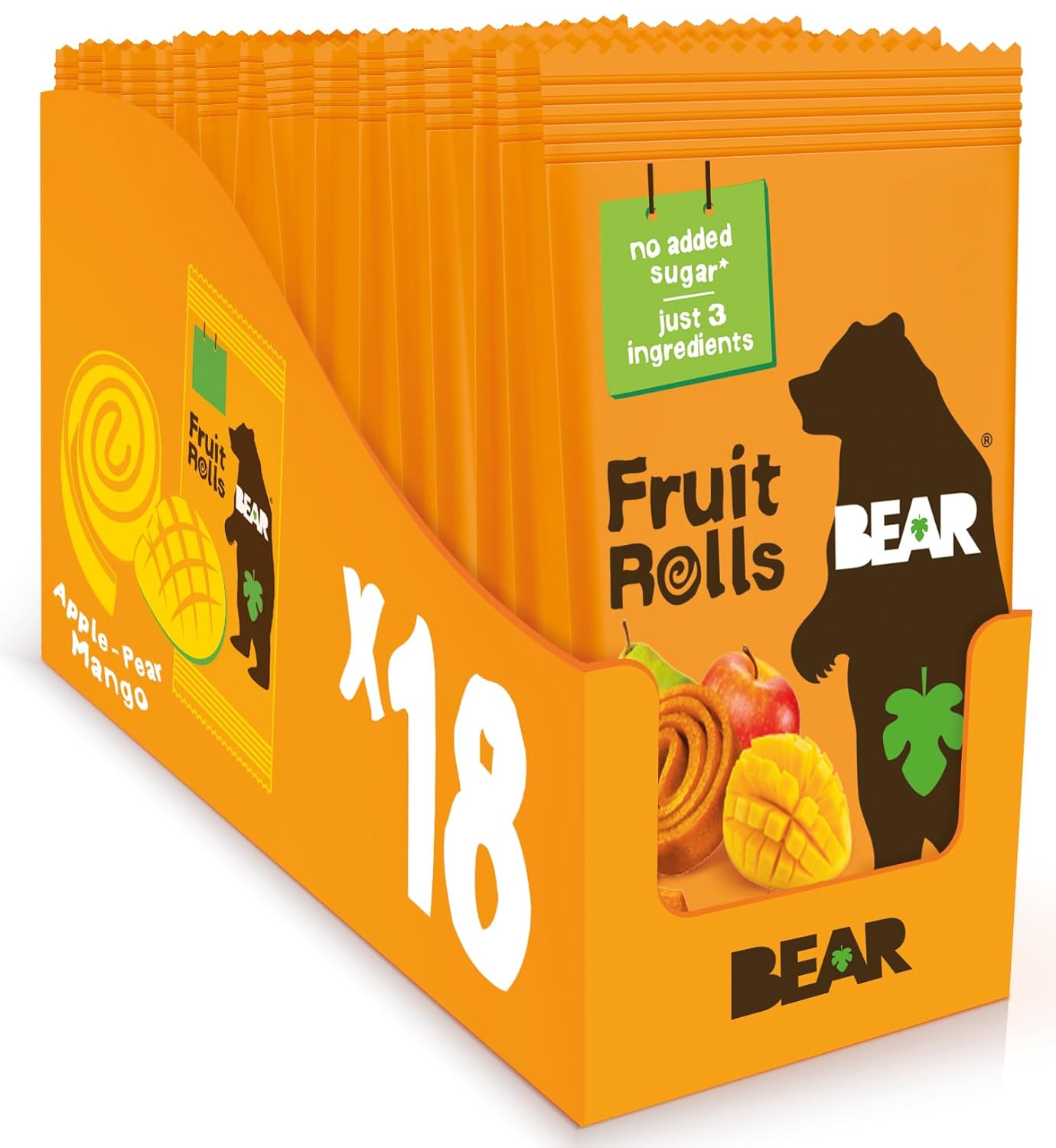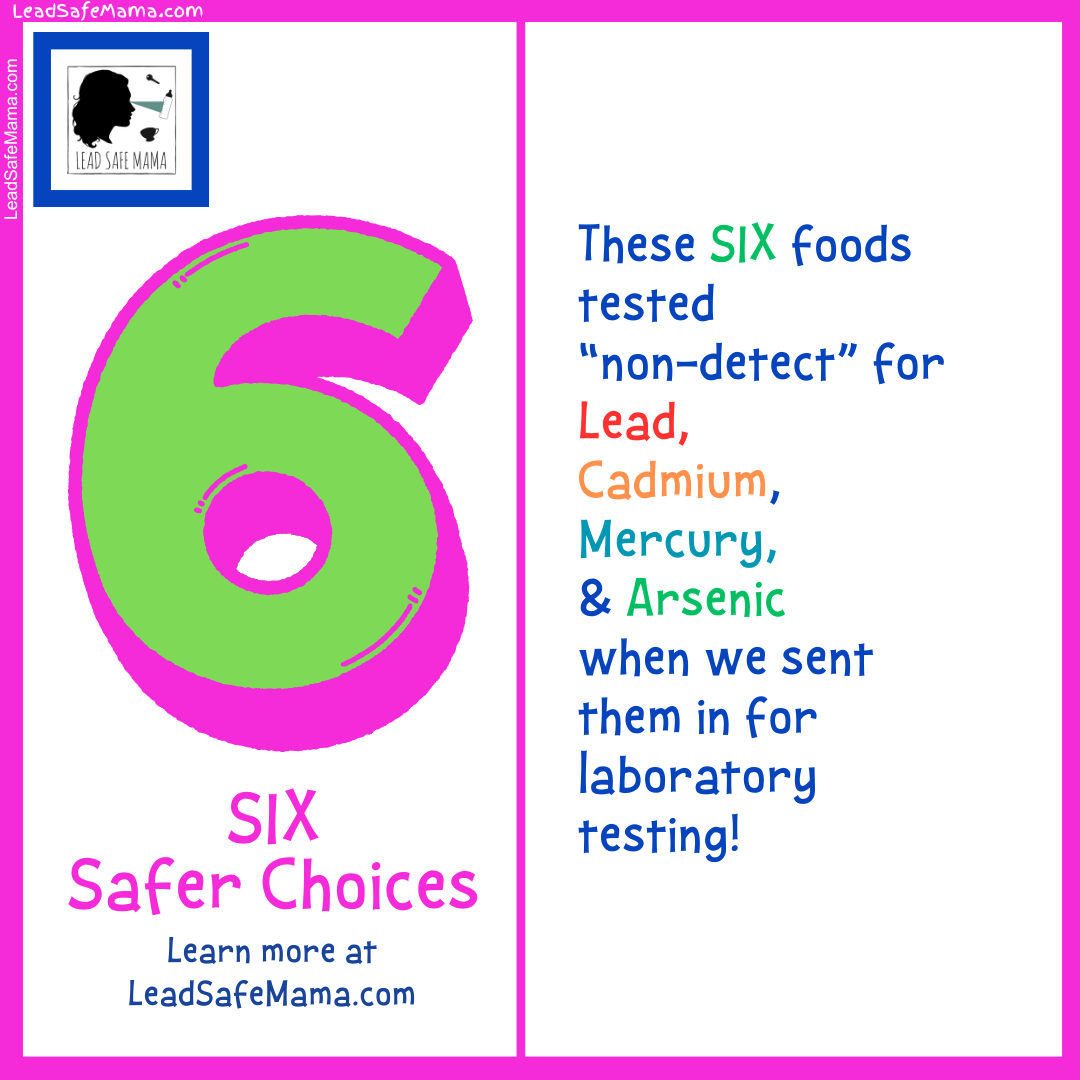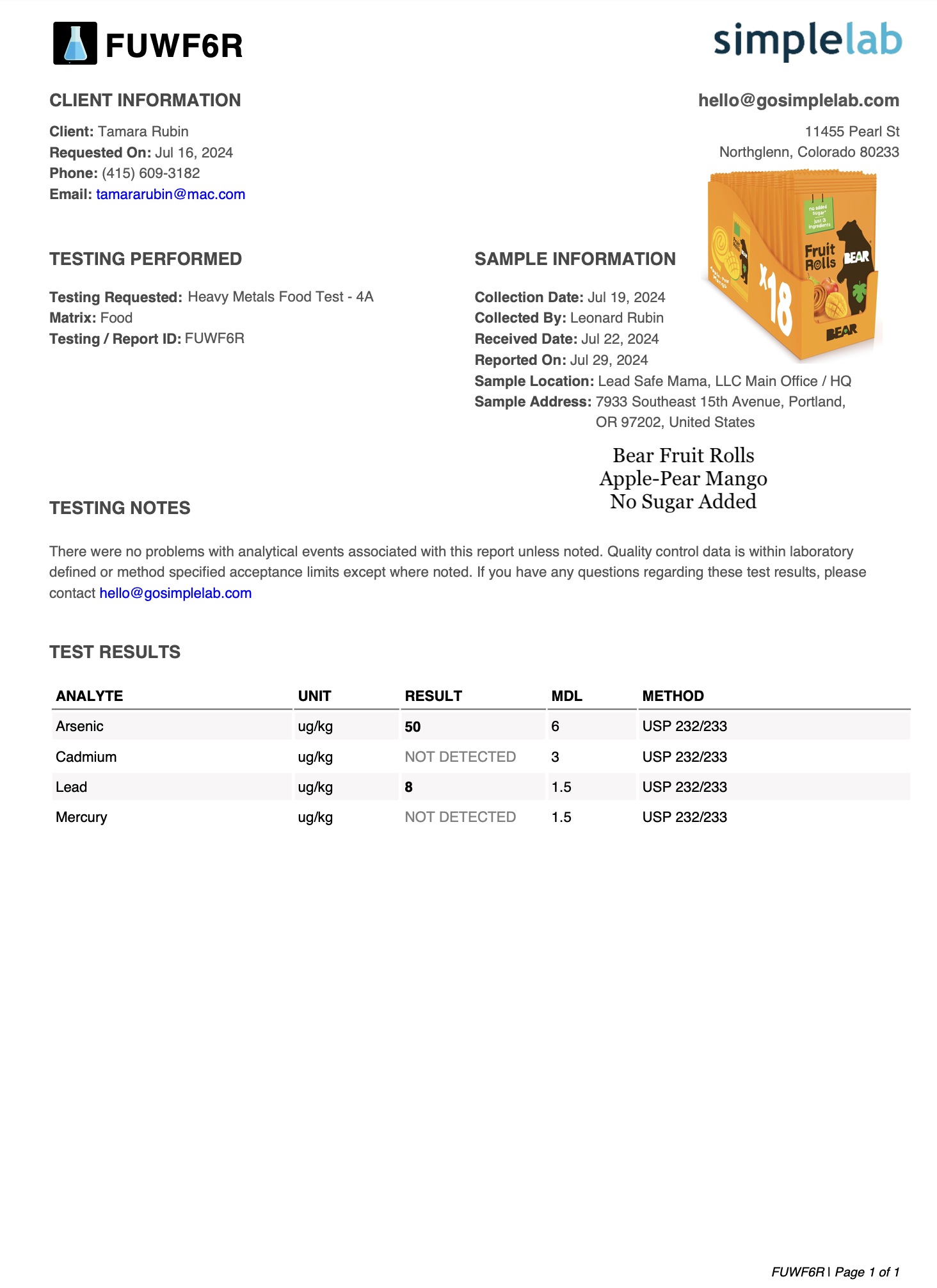Bear Fruit Rolls in Apple-Pear Mango flavor test positive for unsafe levels of Lead & Arsenic — July 2024 lab report
For those new to the Lead Safe Mama website:
Tamara Rubin is a multiple-federal-award-winning independent advocate for childhood Lead poisoning prevention and consumer goods safety, and a documentary filmmaker. She is also a mother of Lead-poisoned children (two of her four sons were acutely Lead-poisoned in 2005).
- Tamara owns and runs Lead Safe Mama, LLC — a unique community collaborative woman-owned small business for childhood Lead poisoning prevention and consumer goods safety.
- Since July of 2022, the work of Lead Safe Mama, LLC has been responsible for five product recalls (FDA and CPSC).
- All test results reported on this website are science-based, accurate, and replicable.
- Please check out our press page to see some of the amazing coverage of our work so far this year!
This is an ad-free article.
Advertising and affiliate income help Lead Safe Mama, LLC cover the costs of the work we do here (independent consumer goods testing and childhood Lead poisoning prevention advocacy). We have removed ads from most of our more widely-read articles (and newly published articles, too — like this one!) to make them easier for you to read. In addition to supporting this work by starting any shopping you might be doing with a click on our affiliate links, if you would like to support the independent consumer goods testing and childhood Lead poisoning prevention advocacy work of Lead Safe Mama, LLC by making a contribution (which will also help us keep our more widely-read articles ad-free), click here. Thank you!
Important Background: What is an Action Level?
Please note the following key points:
The original lab report for this product is below (at the bottom of this page).
The graphic above shows the levels of metals detected in this product (in red) along with the low threshold of detection (in green) for each of the metals not detected with the laboratory testing Lead Safe Mama, LLC completed for this product. The numbers are juxtaposed (in blue) to the “Action Level” proposed by the medical and scientific community in 2021 as part of the Baby Food Safety Act.
- These 2021 levels were proposed as “Action Levels” because they are (in fact) protective of human health.
- An “Action Level” is NOT the same as a “Maximum Allowable Level.”
- Many food manufacturers misinterpret guidance on heavy metals to mean “allowable levels” and consider it reasonable for their products to test positive below these levels.
- This is a (perhaps intentional?) misunderstanding/ misinterpretation the food industry makes — a misunderstanding which food manufacturers use to justify the presence of heavy metals in their products.
- There is no safe level of Lead exposure.
- Lead bioaccumulates in the body.
- Lead bio-mimics Calcium in all biological structures.
- If Lead is present, the human body stores it in Calcium-dense biological structures (the brain, bones, organs, teeth, etc.) in place of Calcium.
- Nearly all the Lead you have been exposed to in your life is still stored in your body. You can learn more about this by watching our documentary film on childhood Lead poisoning — linked here.
- It is the cumulative impact of heavy metal exposure (over a lifetime) that makes even small/ incidental/ seemingly trivial exposures particularly damaging and dangerous. You can read more about that here.
- Once a food product has the amount of heavy metal (Lead, Cadmium, Mercury, or Arsenic) noted (above) as the “Action Level,” that food product is officially considered (by the scientific and medical community) unsafe for consumption by children as toxicants (found at-or-above these levels) are in the range of heavy metal levels that have been demonstrated to cause lasting harm.
- Action Levels are not related to serving size.
- Action Levels are relevant for any amount of a food product that may be consumed (any quantity of the food in question).
- PPB (parts per billion/ ppb) measurements are a percentage (albeit a very small percentage) and apply to any quantity of the food product tested.
- For more discussion about serving size considerations (and why relying on “serving size” to limit toxicant exposure is not a relevant metric/ not a metric protective of human health), read this article.
- These “Action Levels” proposed in 2021 are the levels at which the scientific and medical community believe the manufacturer (or government) needs to take ACTION to fix the problem.
- One “Action” would be for the manufacturer to take steps to reduce the levels of toxicants in the food product.
- Another “Action” would be for the manufacturer to cease sales of the product until the product could be made safe.
- Another “Action” would be for the manufacturer to inform the public that a specific food product has an unsafe level of the metal detected at-or-above the “Action Level” — making a highly-visible public announcement regarding which relevant batches of the product should be recalled/ not consumed.
- The Action Levels proposed with the Baby Food Safety Act of 2021 were not arbitrary toxicant levels, but were proposed because they are the levels most protective of human health. However, the Baby Food Safety Act of 2021 was not passed into law.
- Regardless of the fact the Baby Food Safety Act of 2021 never passed into law — and it is therefore legal to have food for children test positive for Lead, Cadmium, Mercury, and Arsenic at-or-above these levels — these Action Levels still reflect the current (modern/ relevant) advice of the medical and scientific communities as levels both achievable by the industry and safeguards of infant and toddler health.
- Food industry lobbyists fought against formalizing these proposed “Action Levels” as a government standard, alleging they were unachievable.
- The image below (with the number SIX) links to a landing page with SIX food products we have already tested this year (2024), all of which have been “non-detect” for toxicants with low thresholds of detection (for Lead, Mercury, Cadmium, and Arsenic) far below the 2021 proposed Action Levels.
- These SIX food products (about 10% of the foods Lead Safe Mama, LLC has tested and reported on so far since we started laboratory testing for food in March 2024) clearly demonstrate these Action Levels as achievable across a range of food types (salt, flour, coffee, oatmeal, chia seeds, and a soda product — plus we are about to add one more beverage to that list this month and bring it to seven “non-detect” foods).
- The legitimacy of these levels as “Action Levels”/ “Levels of Concern” (even though they were not adopted as law) is further supported in its similarity to the legitimacy of the America Academy of Pediatrics’ level of concern for Lead in water — which is 1 ppb — even though the FDA’s official “level of concern” for Lead in water is 15 ppb (you can read more about that here).
For safer snack ideas, click here.
For links to all six food items we have tested so far that tested “non-detect” for Lead, Cadmium, Mercury, and Arsenic, click the image below (with the big green and pink number six)!
Published: August 17, 2024
Hello! We are working on publishing a LOT of test results very quickly this week.
We will be updating this section of each article (with more information about the specific product and other similar products for context) in the next week or two, but we wanted to make sure the greater Lead Safe Mama community (and the general public) had access to this scientific data (about foods and supplements in their home) as quickly as possible.
Please scroll down to see the full lab report for the product pictured above.
Thank you for your patience.
Please do check out the other links on this page for additional information about the truly independent, third party, laboratory testing we are conducting on food products.
As there are almost no reasonable safety thresholds proposed for toxicants (heavy metals) consumed by adults (in foods and supplements), our focus is (as always) on the health of children. The available proposed safety thresholds (and guidance) for foods consumed by adults are not levels that are protective of human health and therefore are not relevant to the work we do here at Lead Safe Mama, LLC.
Some additional reading & links that may be of interest:
- This is the Lead Safe Mama affiliate link to purchase the test kits we used for this testing.
- Here’s our landing page with links to all the food test results for products we have tested and reported on so far.
- Here’s our landing page listing all the food testing we have in-progress (at the lab/ pending, etc.) — please consider making a contribution in support of any of the pending crowd-funded foods if they are a food you use! Thank you.
- Here’s information on how to send your own food samples into a lab for testing (the cost is $195 per single food sample tested for Lead, Cadmium, Mercury, and Arsenic) and how to collaborate with Lead Safe Mama, LLC on the food testing we are hosting.
Amazon links are affiliate links. If you purchase something after clicking on a Lead Safe Mama, LLC Amazon affiliate link, Lead Safe Mama, LLC may receive a percentage of what you spend — at no extra cost to you.
Lab report for the Bear Fruit Rolls
in Apple-Pear Mango flavor, pictured below:
Never Miss an Important Article Again!
Join our Email List










Since these are minimal ingredients I’m wondering if the “That’s It” bars made with apples and another fruit (I.E. mango, blueberry) could contain arsenic as well
This is our first of this type of product we have tested – so we will learn more soon!
We have some other “fruit only” products in the queue:
https://tamararubin.com/2024/06/food-testing-fundraising-campaigns-update-all-batches-of-lead-safe-mama-llc-food-testing-2024/
Tamara
Also wondering about the That’s It fruit bars! We give both to our daughter as a healthy alternative. I guess not anymore. Thank goodness Costco takes returns.
So, based on your previous conclusions, the lead is probably from the manufacturing. What do you hypothesize is the source of the arsenic?
This is a big one for us- my kids daily snack because there’s no flour, no crappy oil, no cocoa etc!
We need to see the test results for more dried, concentrated fruit products before I can draw any conclusions actually – especially given this is the first food like this that we have tested.
T
We have these same brand fruit rolls in another flavor. Should we avoid them?
Yes
Hi Tamara, is this the version manufactured in the US or elsewhere please?
Thank you